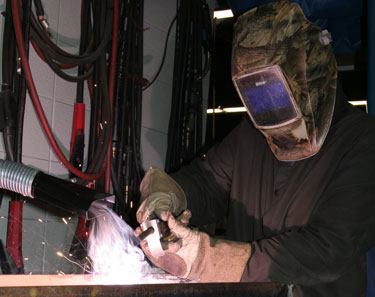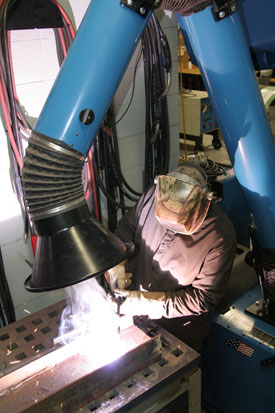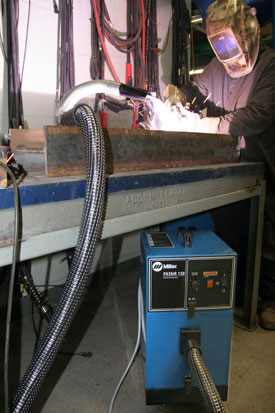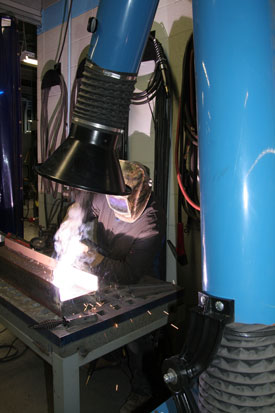
A variety of suction hoods, including a fume removal MIG gun, are available
for the FILTAIR 130 to meet the needs of fume extraction applications.
Welding fume extractors can offer employers a number of benefits, including attracting talented welders, reduced equipment costs and ensuring compliance with federal regulations, but companies need to consider a range of factors in order to make the right equipment purchase.
In today's market, many employers need skilled welders. With the welding workforce aging and fewer new welders entering the industry, highly skilled welders can choose where they want to work. Establishing a clean, healthy working environment through the use of a fume extraction system enables employers to gain a competitive advantage in retaining and recruiting skilled welders.
Fume extraction systems offer additional advantages, such as reductions in overhead and operating expenses. Companies that integrate a fume extraction system into their welding operations are also better positioned to negotiate favorable liability and health insurance rates with their insurers. Additionally, fume extraction systems prolong the life of electronic equipment and power sources in a welding shop by removing particulates from the air and preventing equipment breakdowns. Not only will a fume extraction system decrease a company's maintenance costs, it will also increase the lifespan of all equipment in the welding shop.
Finally, new regulations from the Occupational Safety and Health Administration ("OSHA") lower the exposure limits for hexavalent chromium. Fume extraction systems can help companies comply with these new regulations and reduce their employees' exposures.
Because of differences that exist in the workplace, companies should give thoughtful consideration to choosing the best fume extraction system for their business. Here are some features companies should evaluate when selecting a fume extraction system.

The FILTAIR MWX-D features an articulating arm that allows the suction hood to be placed in an unobtrusive location, yet close enough to extract nearly all of the welding fumes.
1. The Type of Fume Extraction System
There are three basic ways to provide respiratory protection: (1) engineered systems; (2) source capture extraction devices; and (3) personal protection equipment, such as respirators. While all of these methods can be effective, many employers elect to use a combination of methods to ensure workers' safety. Understanding each method is the critical first step in selecting the appropriate fume extraction system.
"Engineered systems" generally involve the installation of fans and ductwork to remove welding fumes from an area. Because these systems require significant engineering and labor costs, they are the most expensive way to provide respiratory protection. Although engineered systems effectively remove fumes and gases from an area. They typically do not capture at the source.
"Source capture" devices remove welding fumes directly at the arc. Source capture devices filter the fumes and release the "cleaned" air back into the work environment. Source capture devices remove fumes as soon as they are created. Source capture devices are less expensive and usually more flexible than engineered systems, but are more costly than respirators.
Manufacturers offer a wide array of respirators. Half-masks tightly fit to the employee's face while personal air-powered respirators ("PAPRs") use an air filter and blower to circulate clean air into the welding helmet. These types of respiratory protection are particularly effective when welding in confined areas or when source capture is not feasible. Although they provide sufficient protection for individual operators, they do not address the underlying issue of fumes in the welding shop. When compared to engineered systems and source capture devices, respirators typically cost the least.

Its small size and light weight allow the FILTAIR 130 to be positioned
under a table or carriedthroughout a multi-level job site.
2. The Filter
The heart of a fume extraction system is the filter. Evaluating the type of filter in a fume extraction system is the single most important factor to consider when purchasing a source capture fume extraction system. The filter's material and its method of manufacture significantly affect the size of particles it can capture. Many fume extraction systems are manufactured with filters that have not been designed specifically to collect the submicron particles found in welding fumes. On the other hand, filters designed specifically for welding fumes capture more submicron particles before clogging and dramatically decrease the pressure drop that occurs as the filter gradually fills with particles.
The most accurate rating system for measuring the effectiveness of filters is the Minimal Efficiency Reporting Value ("MERV"). This rating system is recognized and recommended by the American Society of Heating, Refrigerating and Air-Conditioning Engineers. The MERV rating reflects the effectiveness of a filter based on the size of the particles it can capture.
Standard cellulose filters rate a 7 to 10 on the MERV scale, which means they are not rated to capture particles smaller than 1 micron. Another common filter material is spun-bound polyester; it is rated an 11 on the MERV scale. An 11 rating indicates that these filters are not very efficient at capturing particles smaller than 1 micron, either.
Sometimes, manufacturers "seed" filters by pre-loading them with a special powder that fills the gaps through which submicron welding fume particles can pass. Other manufacturers attempt to increase the efficiencies of standard cellulose and spun-bound polyester filters by melting blown fiber layers to these filters. However, both pre-seeded and melt-blown filters are highly susceptible to pressure drop or decreased filtration capacity, as well as shortened filter life.
Nanofiber filters, with a MERV rating of 15, offer one of the highest MERV ratings for fume extraction systems. These filters immediately capture up to 95% of submicron particles found in welding fumes and quickly begin to filter out up to 99.998% of submicron particles. Nanofiber filters store the fume particulates on the surface of the filter ("surface loading"), rather than allowing them to infiltrate the interior of the filter material ("depth loading"). Compared to standard filters, nanofiber filters are also more resistant to pressure drop as the filter loads with fume particles. Since nanofiber filters require less cleaning than standard filters, they will also last longer before needing to be replaced.
3. Airflow
The third factor to consider in evaluating fume extraction systems is airflow, which is the amount of air the system circulates. All fume extraction systems are rated based on the amount of cubic feet of air they circulate each minute (cubic feet per minute or "CFM"). Because manufacturers measure and advertise the effectiveness of fume extraction systems differently, an understanding of how airflow is measured is essential when selecting a fume extraction system.
The most accurate method to measure airflow is at the welding hood. A fume extractor that is rated to 700 CFM at the opening of the blower cabinet might extract only 600 to 650 CFM at the hood when new. Several factors, including the suction arm, the hood, the blower, the cabinet design and the type of filter, affect a fume extraction system's ability to circulate air. Multiple bends in the suction arm, mechanical articulators within the arm, and a poorly configured cabinet can reduce airflow to the filter. Airflow measurements at the hood, both when the system is new and when the filter is at full capacity, are important factors to consider when purchasing a fume extraction system. Since the correct amount and type of airflow depends on a wide variety of factors, consulting a welding distributor or fume extraction system manufacturer will help determine the best extraction system for your welding application.

The FILTAIR MWX-D features an articulating arm that allows the suction hood to be placed in an unobtrusive location, yet close enough to extract nearly all of the welding fumes.
4. Disposable versus Self-Cleaning
Fume extraction systems are available as either disposable or self-cleaning units. Disposable units, as their name implies, use filters that are designed to be discarded when the filters reach their capacities. A self-cleaning filter may be used many times since the entrapped particles may be cleaned repeatedly from the filter's surface. Disposable models offer lower up-front costs, however, the recurring expense of replacing disposable filters can increase the overall cost.. Although their initial cost is higher, self-cleaning models provide ongoing cost savings since their filters are reusable.
Self-cleaning filters use different cleaning mechanisms and cleaning rates. For example, a depth loading cellulose filter is not only more difficult to fully clean, it also takes the self-cleaning unit as long as 45 minutes to restore the filter to a usable condition. Some self-cleaning fume extraction systems require the presence of an operator during the cleaning process. By contrast, nanofiber filters, because they are surface loading, can be restored in as little as one minute. Selecting a self-cleaning fume extraction system that contains a nanofiber filter and uses a short cleaning cycle can reduce downtime and lost productivity.
5. Other Considerations
After analyzing the four most important factors in selecting a fume extraction system, companies should consider other features that fume extraction systems offer. For example, the user interface should be easily understandable. Companies should also compare the accessibility of the filter for replacement and cleaning, as well as the manufacturers' routine maintenance recommendations.. Obviously, the length and type of warranty coverage is an important consideration. Finally, a product demonstration will allow an evaluation of the level of noise the fume extraction system generates and its ease of maneuverability.
As companies continue their search for competitive advantages in retaining and recruiting skilled welders, maintaining a safe and healthful environment is an appealing incentive for new and current employees. A fume extraction system can extend equipment life, reduce insurance rates and help companies comply with federal regulations. Despite their initial costs, a fume extraction system is an investment that pays many dividends.